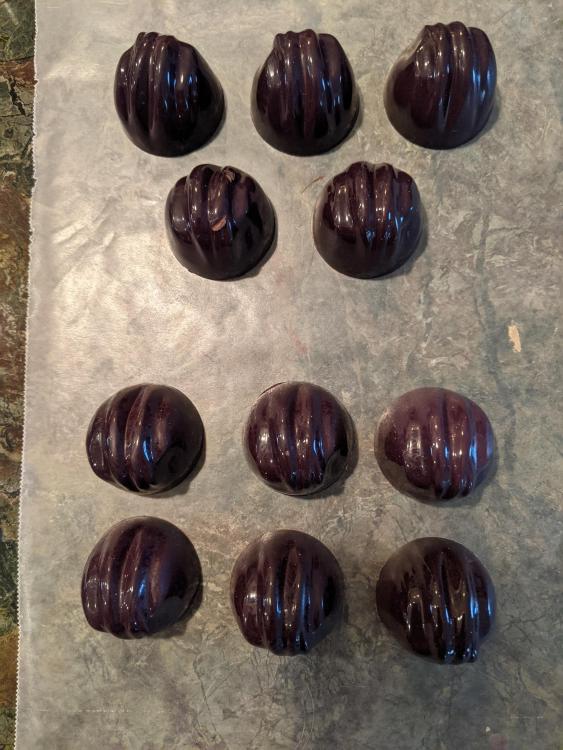@Kerry Beal @pastrygirl This is a continuation of our discussion that originally began under the topic of cleaning colored cocoa butter from molds. It's probably more relevant here.
First, I concluded that the little chips that came off a lot of shells (shown in previous thread) were caused by cleaning the molds on top of a food warming tray that was too warm. If it had been caused just by rubbing them too vigorously on shop towels, the CCB would have come off completely; instead it stuck in the mold when I unmolded. However, the rubbing procedure is relevant (see below).
I did my experimentation on whether CCB needs to be tempered. I used the Fuji to spray both molds. Although the bonbons in the photo below appear not to be colored, they are--with Chef Rubber's idea of what magenta looks like. I sprayed one mold with untempered CCB around 90-95F/32-35C. Excess CCB was very easy to remove because it was not starting to crystallize; in fact, it took more than a half-hour for the CCB to attain the matte look and not come off when I touched it. I was sure I faced a daunting task of cleaning the mold. The second mold I sprayed with CCB I had tempered with 1% by weight of silk (today I happened on a video by Brian Donaghy of Tomric, and he recommended 3%). It was at 86F/30C (I think this is the temp recommended by Andrey Dubovik). It took much longer to attain the matte look than what I have been getting by using more silk, but the time was more like 15 minutes. Again, it was easy to clean the excess CCB from the mold.
I filled both molds with tempered chocolate and let it crystallize. To my surprise, both unmolded equally easily--only a light tap on the counter was necessary. In the photo below the top group is with untempered CCB; the bottom is tempered. There is a defect in one untempered bonbon, the left bonbon in the second row (a bit of CCB stuck in the mold), but aside from that, I saw no other defect, and both are equally shiny. Before I filled the molds with chocolate, I did note that there were some spots with missing CCB on the top edges of the molds (such as showed up in the original post). I assumed this was from rubbing on the towels and was able to replicate the issue by additional rubbing (the fact that the CCB was not crystallizing so fast gave me more time to experiment). I don't know what to do about this except to rub more gently or perhaps find towels that aren't so rough in texture.
Conclusions: This was a very limited experiment, but tempering CCB does not appear to be necessary when airbrushing. Going without, however, takes considerably more time for the CCB to crystallize and may be responsible for the one defect (though this is not certain). I am left to puzzle over several issues: Did the untempered CCB ever properly crystallize? If the act of spraying is supposed to temper it, then it should have firmed up much more quickly. When we temper chocolate, don't we say that the temper is subpar if crystallizing takes a long time? But what happens to the common explanation that CCB sticks in a mold when it isn't tempered? We are left to puzzle over whether the legion of chocolatiers who recommend tempering CCB know something that didn't show up in my experiment. If one is using silk to temper CCB, my experiment suggests that in the past I have been using too much and, as a result, the CCB was crystallizing immediately on being sprayed and was prone to sticking in the mold and to being very difficult to clean off the mold.





